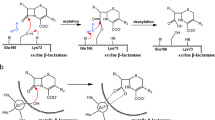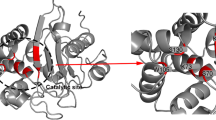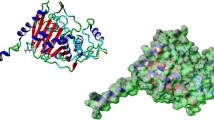Abstract
The treatment of bacterial infections is currently threatened by the emergence of pathogenic bacteria producing β-lactamase, which catalyzes the hydrolysis of β-lactams. Although the hydrolysis of the substrate nitrocefin by a metallo-β-lactamase, namely β-lactamase N1 from USA300 (a typical methicillin-resistant Staphylococcus aureus), has previously been reported in the literature, its mechanism remains elusive. Here, we show that molecular modeling and quantum-mechanical/molecular mechanics (QM/MM) calculations describing the complex of β-lactamase N1 with nitrocefin (the substrate of β-lactamase N1) can predict the catalytic mechanism of nitrocefin hydrolysis by β-lactamase N1. Molecular dynamics simulation shows that the catalytic reaction begins with hydrogen bond formation between Gln171 and a water molecule, which is thereby captured for nitrocefin hydrolysis by β-lactamase N1. In addition, the carboxyl group coordinates Zn2 in a chelating fashion. The binding energy decompositions suggest that Phe169 anchors nitrocefin by π-stacking interactions between the benzene rings. Specifically, Phe169 and Zn2 position the nitrocefin in specific orientations. The active site of β-lactamase N1 contains two residues (Gln171 and Phe169) that we expected to be crucial for guiding the nitrocefin hydrolysis reaction. Compelling evidence is provided that the mutants F169A and Q171A show lower enzymatic activity than the wild-type protein. On the basis of the QM/MM calculations, we propose that nitrocefin hydrolysis is initiated by the interaction between the oxygen atom of water and the C18 atom of nitrocefin, leading to the opening of the four-membered ring of nitrocefin and the formation of a substrate intermediate. In the next step, a hydrogen atom transfers from the nitrogen atom to the C11 atom of nitrocefin, resulting in the stable product.










Similar content being viewed by others
References
The antibiotic alarm (2013). Nature 495(7440):141
Berendonk TU, Manaia CM, Merlin C, Fatta-Kassinos D, Cytryn E, Walsh F, Burgmann H, Sorum H, Norstrom M, Pons MN, Kreuzinger N, Huovinen P, Stefani S, Schwartz T, Kisand V, Baquero F, Martinez JL (2015) Tackling antibiotic resistance: the environmental framework. Nat Rev Microbiol 13(5):310–317. https://doi.org/10.1038/nrmicro3439
Bush K (2013) Proliferation and significance of clinically relevant beta-lactamases. Ann N Y Acad Sci 1277:84–90. https://doi.org/10.1111/nyas.12023
King DT, Strynadka NC (2013) Targeting metallo-beta-lactamase enzymes in antibiotic resistance. Future Med Chem 5(11):1243–1263. https://doi.org/10.4155/fmc.13.55
Hall BG, Barlow M (2005) Revised ambler classification of {beta}-lactamases. J Antimicrob Chemother 55(6):1050–1051. https://doi.org/10.1093/jac/dki130
Bush K, Jacoby GA (2010) Updated functional classification of beta-lactamases. Antimicrob Agents Chemother 54(3):969–976. https://doi.org/10.1128/AAC.01009-09
Drawz SM, Bonomo RA (2010) Three decades of beta-lactamase inhibitors. Clin Microbiol Rev 23(1):160–201. https://doi.org/10.1128/CMR.00037-09
Neuwald AF, Liu JS, Lipman DJ, Lawrence CE (1997) Extracting protein alignment models from the sequence database. Nucleic Acids Res 25(9):1665–1677
Carfi A, Pares S, Duee E, Galleni M, Duez C, Frere JM, Dideberg O (1995) The 3-D structure of a zinc metallo-beta-lactamase from Bacillus cereus reveals a new type of protein fold. EMBO J 14(20):4914–4921
Aravind L (1999) An evolutionary classification of the metallo-ß-lactamase fold proteins. In Silico Biol 1(2):69–91
Daiyasu H, Osaka K, Ishino Y, Toh H (2001) Expansion of the zinc metallo-hydrolase family of the beta-lactamase fold. FEBS Lett 503(1):1–6
Yang Y, Rasmussen BA, Bush K (1992) Biochemical characterization of the metallo-beta-lactamase CcrA from Bacteroides fragilis TAL3636. Antimicrob Agents Chemother 36(5):1155–1157
Felici A, Amicosante G, Oratore A, Strom R, Ledent P, Joris B, Fanuel L, Frere JM (1993) An overview of the kinetic parameters of class B beta-lactamases. Biochem J 291(Pt 1):151–155
Felici A, Amicosante G (1995) Kinetic analysis of extension of substrate specificity with Xanthomonas maltophilia, Aeromonas hydrophila, and Bacillus cereus metallo-beta-lactamases. Antimicrob Agents Chemother 39(1):192–199
Rasmussen BA, Yang Y, Jacobus N, Bush K (1994) Contribution of enzymatic properties, cell permeability, and enzyme expression to microbiological activities of beta-lactams in three Bacteroides fragilis isolates that harbor a metallo-beta-lactamase gene. Antimicrob Agents Chemother 38(9):2116–2120
Concha NO, Rasmussen BA, Bush K, Herzberg O (1996) Crystal structure of the wide-spectrum binuclear zinc beta-lactamase from Bacteroides fragilis. Structure 4(7):823–836
Fitzgerald PM, Wu JK, Toney JH (1998) Unanticipated inhibition of the metallo-beta-lactamase from Bacteroides fragilis by 4-morpholineethanesulfonic acid (MES): a crystallographic study at 1.85-a resolution. Biochemistry 37(19):6791–6800. https://doi.org/10.1021/bi9730339
Davies RB, Abraham EP (1974) Metal cofactor requirements of beta-lactamase II. Biochem J 143(1):129–135
Bandoh K, Muto Y, Watanabe K, Katoh N, Ueno K (1991) Biochemical properties and purification of metallo-beta-lactamase from Bacteroides fragilis. Antimicrob Agents Chemother 35(2):371–372
Garces F, Fernandez FJ, Montella C, Penya-Soler E, Prohens R, Aguilar J, Baldoma L, Coll M, Badia J, Vega MC (2010) Molecular architecture of the Mn2+−dependent lactonase UlaG reveals an RNase-like metallo-beta-lactamase fold and a novel quaternary structure. J Mol Biol 398(5):715–729. https://doi.org/10.1016/j.jmb.2010.03.041
Salimraj R, Zhang L, Hinchliffe P, Wellington EM, Brem J, Schofield CJ, Gaze WH, Spencer J (2016) Structural and biochemical characterization of Rm3, a subclass B3 metallo-beta-lactamase identified from a functional metagenomic study. Antimicrob Agents Chemother 60(10):5828–5840. https://doi.org/10.1128/AAC.00750-16
Ghavami A, Labbe G, Brem J, Goodfellow VJ, Marrone L, Tanner CA, King DT, Lam M, Strynadka NC, Pillai DR, Siemann S, Spencer J, Schofield CJ, Dmitrienko GI (2015) Assay for drug discovery: synthesis and testing of nitrocefin analogues for use as beta-lactamase substrates. Anal Biochem 486:75–77. https://doi.org/10.1016/j.ab.2015.06.032
Qiu J, Niu X, Dong J, Wang D, Wang J, Li H, Luo M, Li S, Feng H, Deng X (2012) Baicalin protects mice from Staphylococcus aureus pneumonia via inhibition of the cytolytic activity of alpha-hemolysin. J Infect Dis 206(2):292–301. https://doi.org/10.1093/infdis/jis336
Newman JA, Hewitt L, Rodrigues C, Solovyova A, Harwood CR, Lewis RJ (2011) Unusual, dual endo- and exonuclease activity in the degradosome explained by crystal structure analysis of RNase J1. Structure 19(9):1241–1251. https://doi.org/10.1016/j.str.2011.06.017
Hess B, Kutzner C, van der Spoel D, Lindahl E (2008) GROMACS 4: algorithms for highly efficient, load-balanced, and scalable molecular simulation. J Chem Theory Comput 4(3):435–447. https://doi.org/10.1021/ct700301q
Pronk S, Pall S, Schulz R, Larsson P, Bjelkmar P, Apostolov R, Shirts MR, Smith JC, Kasson PM, van der Spoel D, Hess B, Lindahl E (2013) GROMACS 4.5: a high-throughput and highly parallel open source molecular simulation toolkit. Bioinformatics 29(7):845–854. https://doi.org/10.1093/bioinformatics/btt055
Morris GM, Huey R, Lindstrom W, Sanner MF, Belew RK, Goodsell DS, Olson AJ (2009) AutoDock4 and AutoDockTools4: automated docking with selective receptor flexibility. J Comput Chem 30(16):2785–2791
Wang J, Wang W, Kollman PA, Case DA (2006) Automatic atom type and bond type perception in molecular mechanical calculations. J Mol Graph Model 25(2):247–260. https://doi.org/10.1016/j.jmgm.2005.12.005
Jakalian A, Jack DB, Bayly CI (2002) Fast, efficient generation of high-quality atomic charges. AM1-BCC model: II. Parameterization and validation. J Comput Chem 23(16):1623–1641. https://doi.org/10.1002/jcc.10128
Punkvang A, Saparpakorn P, Hannongbua S, Wolschann P, Beyer A, Pungpo P (2010) Investigating the structural basis of arylamides to improve potency against M. Tuberculosis strain through molecular dynamics simulations. Eur J Med Chem 45(12):5585–5593. https://doi.org/10.1016/j.ejmech.2010.09.008
Schaffner-Barbero C, Gil-Redondo R, Ruiz-Avila LB, Huecas S, Lappchen T, den Blaauwen T, Diaz JF, Morreale A, Andreu JM (2010) Insights into nucleotide recognition by cell division protein FtsZ from a mant-GTP competition assay and molecular dynamics. Biochemistry 49(49):10458–10472. https://doi.org/10.1021/bi101577p
Acknowledgments
The authors acknowledge the financial support by the National Nature Science Foundation of China [Grant no. 31572566 to X. D. N].
Author information
Authors and Affiliations
Corresponding authors
Additional information
Publisher’s note
Springer Nature remains neutral with regard to jurisdictional claims in published maps and institutional affiliations.
Electronic supplementary material
ESM 1
(DOCX 36 kb)
Rights and permissions
About this article
Cite this article
Yu, Y., Wang, X., Gao, Y. et al. Molecular modeling and QM/MM calculation clarify the catalytic mechanism of β-lactamase N1. J Mol Model 25, 118 (2019). https://doi.org/10.1007/s00894-019-4001-z
Received:
Accepted:
Published:
DOI: https://doi.org/10.1007/s00894-019-4001-z




